全文HTML
--> --> -->回音壁模式最早是在液滴中的球状微腔中被研究的, 液滴表面张力使得微腔表面十分光滑, 因此能够产生具有低阈值和高Q值的激光[17]. 回音壁模式微腔利用介质表面对光的全反射, 使绝大部分光能量被局限在腔体中, 因此在各谐振模式中具有更高的品质因子和更小的模式体积, 另外, 其具有制备工艺简单、成本低等优点. 近年来, 随着微纳技术的不断发展和提高, 基于回音壁模式的圆球、圆柱、圆盘、圆环或者是非圆形的全反射内腔等不同结构的微腔层出不穷[18—21]. 相关的制备工艺上可简单分为“自上而下”(光刻印刷[22]、激光直写[3]、纳米压印[23]、3D打印[24,25]等)和“自下而上”(如自组装[26])两大类. 通过选择适当的加工工艺, 在各种材料体系中, 回音壁模式微腔都得到了长足的发展. 例如, Vahala教授课题组[27]利用半导体工艺在硅衬底上制备了Q值超过108的圆环微腔; 新加坡国立大学的Chen等[28]通过自生长制备了基于氧化锌的六边形圆盘微腔; Soria等[29]通过熔融玻璃的方法制备玻璃微腔; 我国程亚课题组[30]首创的利用激光辅助物理抛光的办法制备基于铌酸锂薄膜的微盘; 以及飞秒激光加工实现了各种材料的微腔(晶体、聚合物、半导体、玻璃、蛋白质等)[31,32].
然而, 目前基于光刻工艺的微腔多为二维或是伪三维的微环、微柱、微盘等, 真正三维的回音壁模式微腔通常是由熔融法、光纤拉锥等方法制备, 而这样的方法对器件的尺寸及形貌的可控性较差. 本文利用飞秒激光直写[33—36]真三维染料掺杂SU-8聚合物有源微球, 制备了各种尺寸的微球体, 其具有良好的表面形貌, 表面粗糙度低于50 nm, 测试得到微腔的Q值约为2100. 染料选择的是荧光产率高的罗丹明B染料, 在温度恒定时, 微球具有稳定的荧光和激射谱. 进而, 随着温度的规律性调控(20 ℃—35 ℃), 染料荧光光谱带的轻微变化使得腔内模式竞争条件变化, 从而微腔的激射谱在一定温度范围内呈类线性漂移. 对品质优良的有源微球腔进行温度漂移的实验能够帮助我们了解和掌握有机染料带来的影响, 同时, 这也给已经制备成形微腔的激射谱微调带来了新的思路和方法.
2.1.试剂与仪器
罗丹明B染料(分析纯), 乙醇(体积分数73%—75%), 丙酮AR(沪试 ≥ 99.5%), 国药集团化学试剂有限公司; 商用SU-8负性光刻胶, 苏州汶颢微流控技术股份有限公司; 去离子水(18.2 MΩ·cm, 25 ℃; 水净化系统购自美国密理博公司).Mai-Tai HP, Spectra-Physics激光器, 美国光谱物理公司; Motic BA400光学显微镜, 麦克奥迪实业集团有限公司; JSM-7500F扫描电子显微镜(SEM), 日本电子株式会社; Andor SR 303i-A光谱仪, 牛津仪器; CT-946平板热台, 深圳邦企创源科技有限公司; Smart Coater旋涂仪, 安赛斯(中国)有限公司.
2
2.2.实验过程
实验流程如图1所示. 首先将加工“墨水”(SU-8光刻胶与环戊酮按体积比1∶1稀释后, 将罗丹明B粉末混入, 最终得到质量比为1.5%的染料掺杂光刻胶墨水)滴加在清洁的玻璃盖玻片上(分别使用丙酮、乙醇和水进行擦拭和清洗), 使用匀胶机进行旋涂, 转速1000 r/min下膜厚约为10 μm. 将旋涂好的样品片置于平板热台上, 95 ℃下进行2 h的前烘, 在前烘过程中, 光刻胶能够紧密地贴覆在衬底上. 前烘完成后关掉热台使样品缓慢冷却至室温, 从而光刻胶能够充分释放内部应力.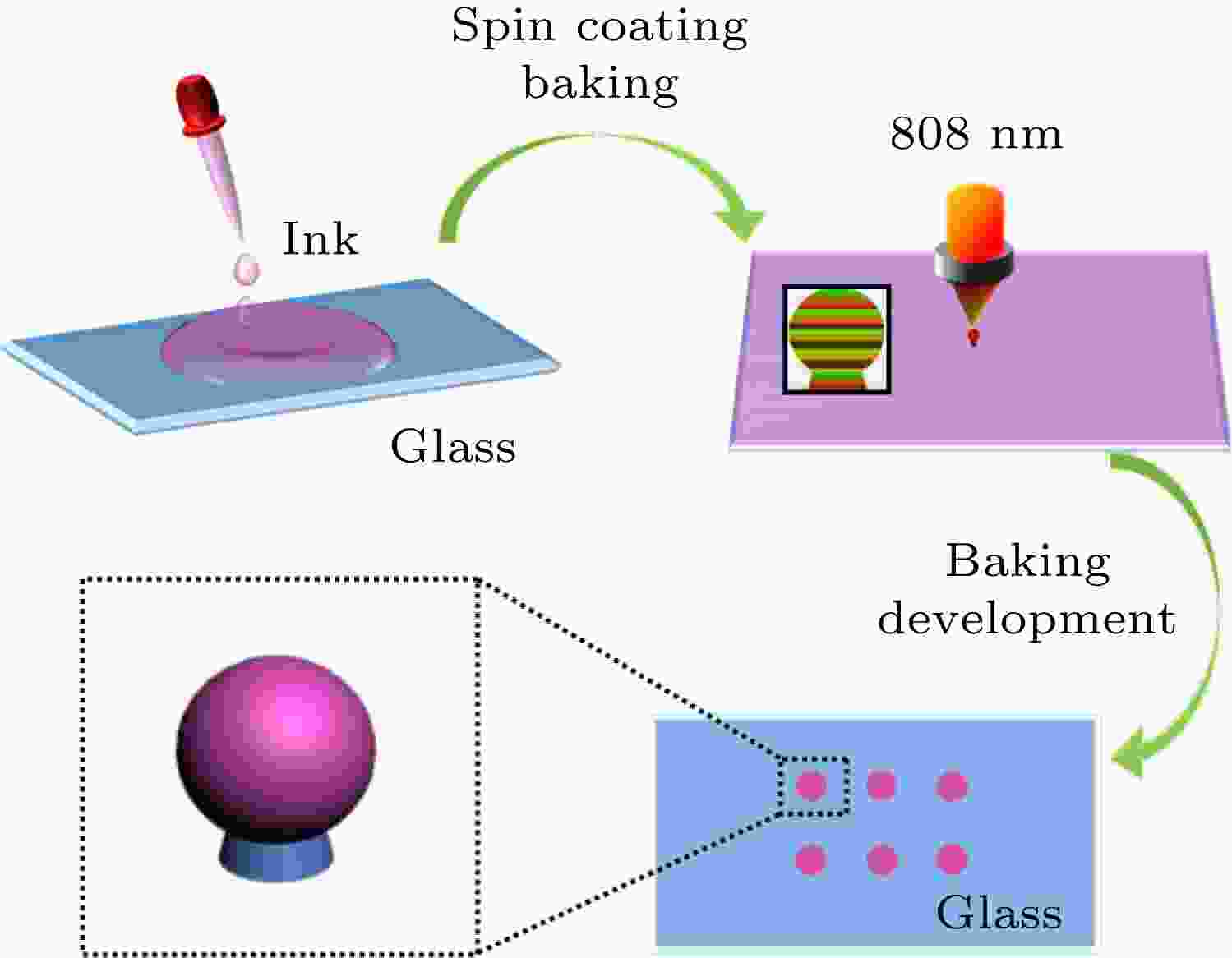 图 1 微球腔飞秒激光光刻流程示意图
图 1 微球腔飞秒激光光刻流程示意图Figure1. Diagram of femtosecond lithography of microsphere cavity.
接下来是对准备好的片子进行飞秒激光扫描. 激光光束(中心波长800 nm, 脉冲宽度100 fs, 重复频率80 MHz)通过油镜(NA = 1.35, 100X, Olympus)紧聚焦于样品中. 光刻胶中的光引发剂同时吸收两个光子产生一种强酸, 其在后烘过程中会作为酸催化剂促进光刻胶单体间的交联, 因此只有光扫描过的地方会产生酸. 我们利用振镜控制样品台的X–Y方向运动, 利用压电平台控制样品台的Z方向移动, 通过设计直写程序就可以实现逐点扫描, 最终在样品片上扫描出如图1所示的带底座的微球.
然后, 我们将经过飞秒激光扫描后的样品片置于95 ℃的热台上进行15 min的后烘, 扫描过程中产生的强酸在后烘过程中促进光刻胶分子间交联. 将后烘完毕的样品片置于丙酮溶液浸泡1 min, 已经发生交联的部分不会被显影液溶解, 而没有曝光的光刻胶就会在显影的过程中被去除. 最后将玻璃片轻轻取出, 分别用乙醇、去离子水小心冲洗玻璃片, 最终得到了染料掺杂的有源回音壁模式微球腔.
3.1.有源微球的形貌表征
图2(a)和图2(b)分别是SU-8光刻胶和罗丹明B的分子式, 图2(c)是将罗丹明B掺入光刻胶后得到的加工墨水. 图2(d)是直径分别为5, 10, 15, 20, 25 μm的微球; 图2(e)是10 μm直径有源微球的显微镜照片和SEM照片, 图2(f)是图2(e)的局部放大照片. 球底部有尺寸更小的底座连接球体和衬底, 是为了减少光的衬底泄露. 可以看到, 飞秒激光双光子聚合能够实现半导体工艺, 光刻工艺等难以实现的真三维加工, 且制备得到的微球具有十分光滑的表面形貌.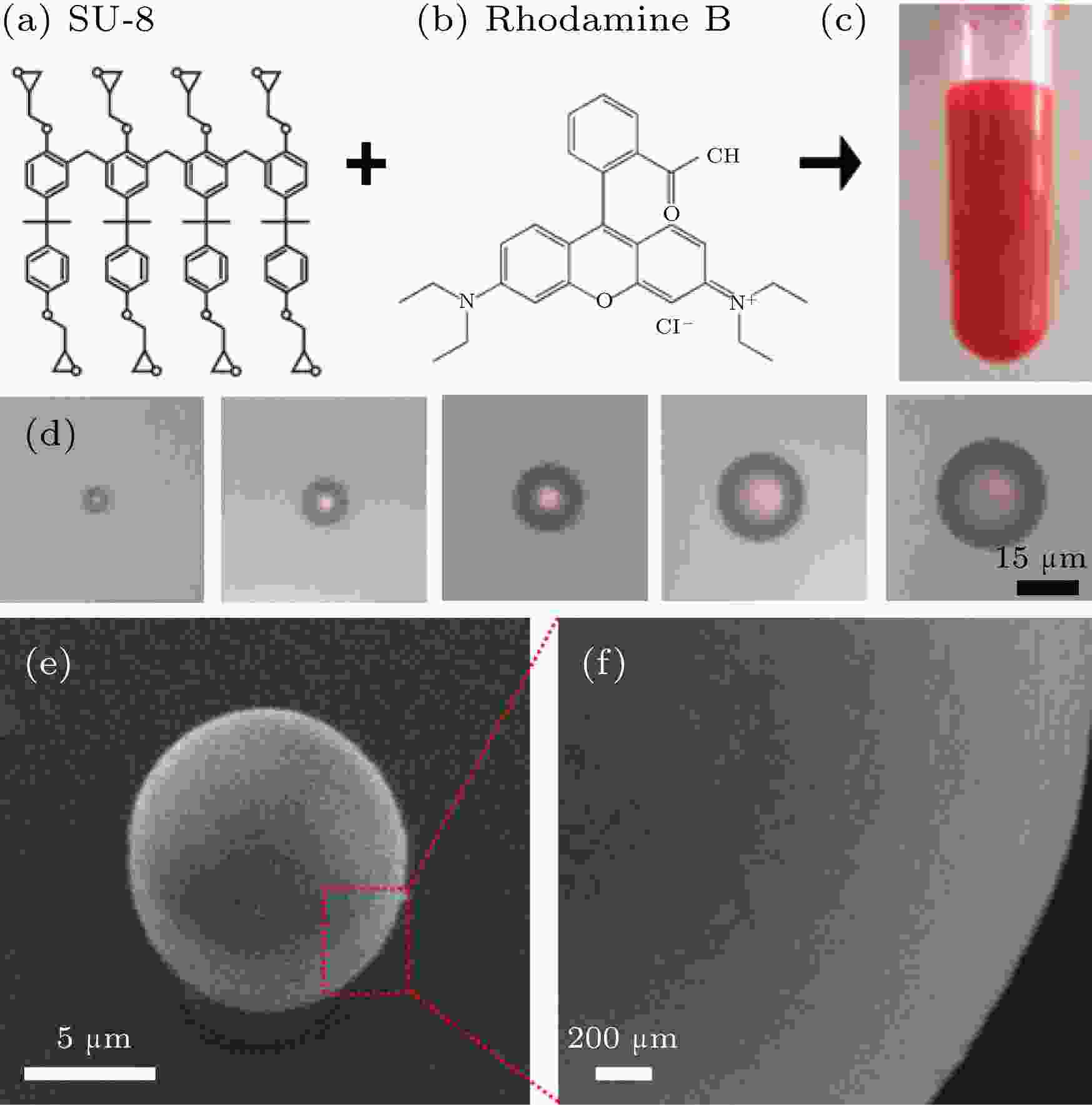 图 2 微腔成分分子式及形貌表征
图 2 微腔成分分子式及形貌表征Figure2. Molecular formula and morphological characterization of microcavity.
2
3.2.有源微球的激射谱测量
我们按照图3搭建了泵浦探测系统. 1064 nm连续皮秒激光器经过BBO晶体倍频, 产生532 nm波长的激光, 作为激励源. 掺杂在SU-8结构中的罗丹明B染料作为工作介质, 罗丹明B (Rhodamine B, RhB)吸收光谱中心波长为525 nm, 发射光谱中心波长为610 nm. 同时, SU-8微结构的折射率约为1.5, 空气的折射率是1, 大的折射率差赋予了微球强的束缚光的能力. 满足了三要素之后, 微球激光器即可工作: 532 nm的泵浦光激发RhB产生中心波长约为630 nm的荧光, 在SU-8微球中通过全反射被不断的放大, 产生激光.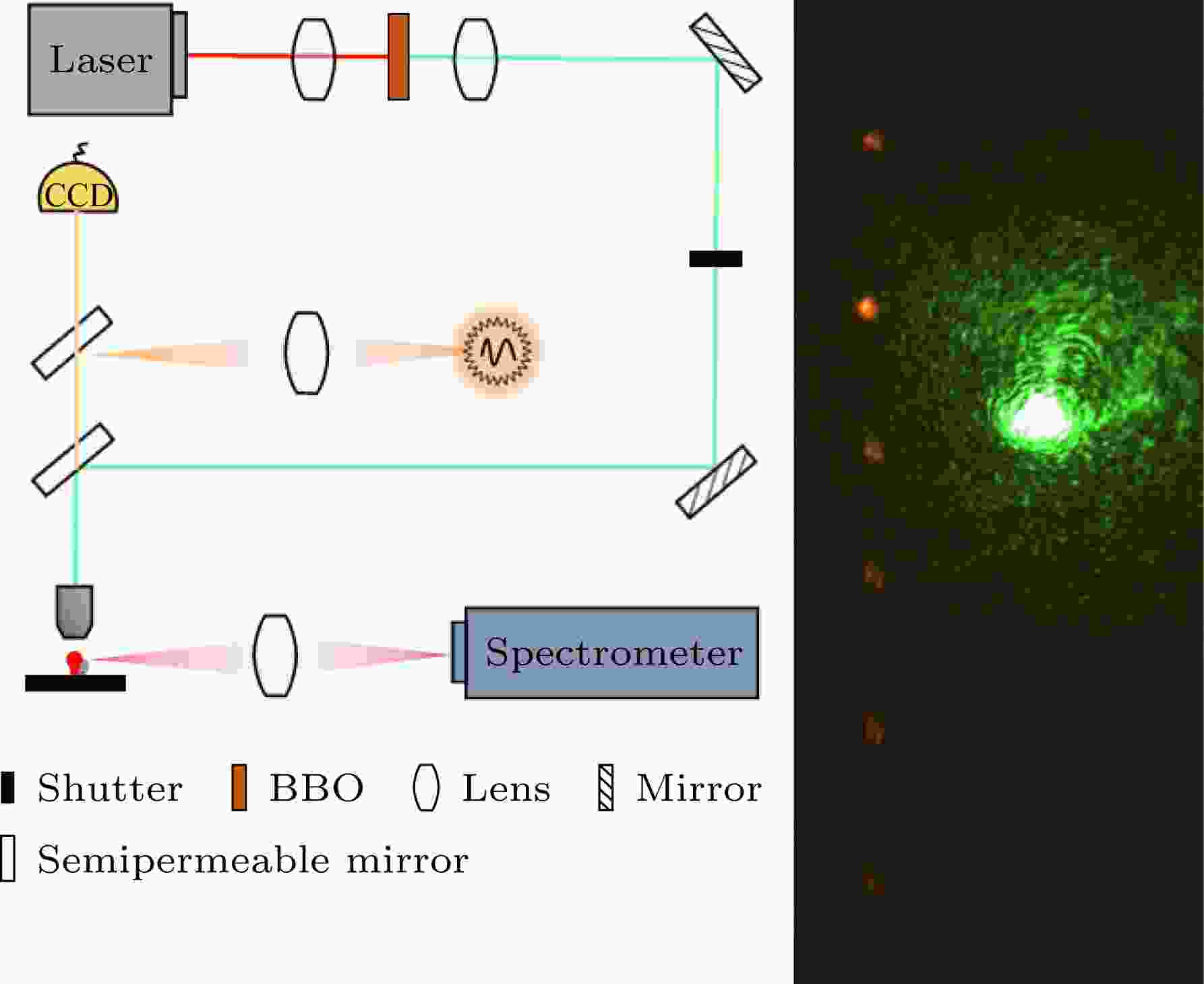 图 3 泵浦探测系统示意图和样品在泵浦光照下的暗场照片
图 3 泵浦探测系统示意图和样品在泵浦光照下的暗场照片Figure3. The schematic diagram of the lasing spectrum measurement system and dark field photography.
我们对直径为10 μm的微球进行泵浦探测, 通过光谱仪(spectrometer)收集并分析激射光谱(见图4). 在光路中加入衰减片调节泵浦光泵浦器件的功率. 每两次连续测量要间隔30 s, 以排除染料漂白带来的影响. 可以发现, 当泵浦功率较低时(72 μJ/cm2), 微球发出微弱荧光(强度约为900)基本没有激射, 逐渐增加泵浦功率, 荧光谱中就会出现一些激射峰, 而且随着泵浦功率的增加, 微球发出的激光强度也缓慢增加. 从主激射峰的最大值与泵浦功率的关系, 可以判断我们制备的有源WGM微球腔的阈值为109 μJ/cm2. 对于回音壁模式微腔来说, 它的品质因子

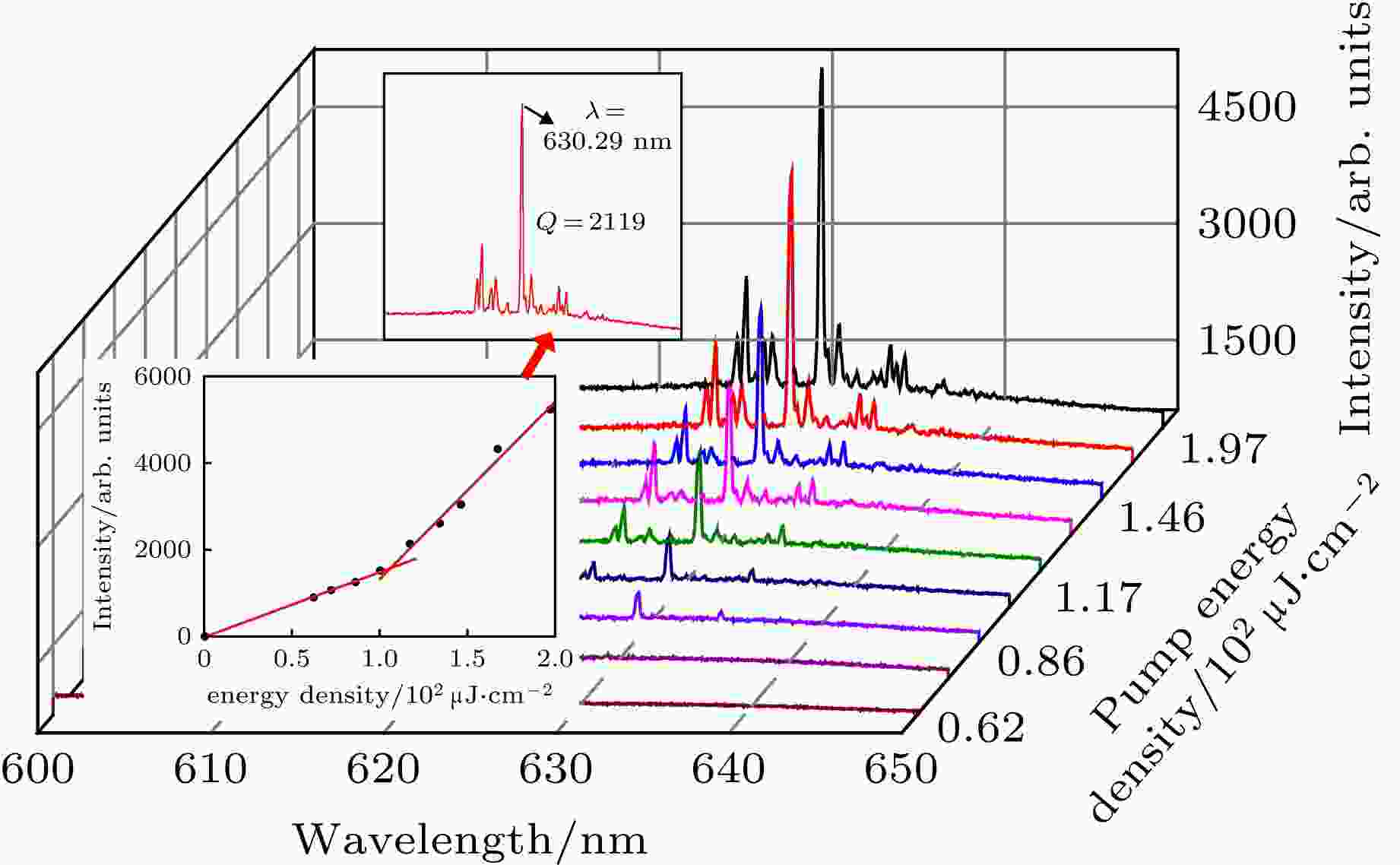 图 4 在不同泵浦能量密度下的激射谱和微腔激光器阈值曲线
图 4 在不同泵浦能量密度下的激射谱和微腔激光器阈值曲线Figure4. Lasing spectra under different pump energy densities and the lasing threshold characteristic.
2
3.3.微激光器的温度调控
在得到较好的微球激光器的样品后, 我们进行了温度调控实验. 在图3测试系统的基础上, 我们在样品玻璃片底部垫上定制的小型热板(加热范围20 ℃—120 ℃, 误差 ± 0.1 ℃), 在侧面用便携式电子温度计直接接触玻璃片, 进一步保证实验温度的准确性. 在做完基础准备后, 首先测量了微球激光器在20 ℃下(环境温度)的激射谱, 然后将样品缓慢增加到25 ℃, 待温度稳定后, 测量微球激光器在25 ℃下的激射谱, 测试顺序和结果如图5(a)所示. 可以看到, 当样品温度从20 ℃增加到35 ℃时, 荧光谱和主激射峰整体红移, 在温度缓慢降回到20 ℃的过程中, 荧光谱带和主激射峰整体蓝移, 且实验可往复. 图5(b)为掺有罗丹明的SU8胶随温度变化的光谱特性. 532 nm峰为激发光波长, 峰位不随温度变化, 而荧光带(600—750 nm)呈现出轻微的漂移, 我们将左侧带边放大, 可以清晰地看到单向移动.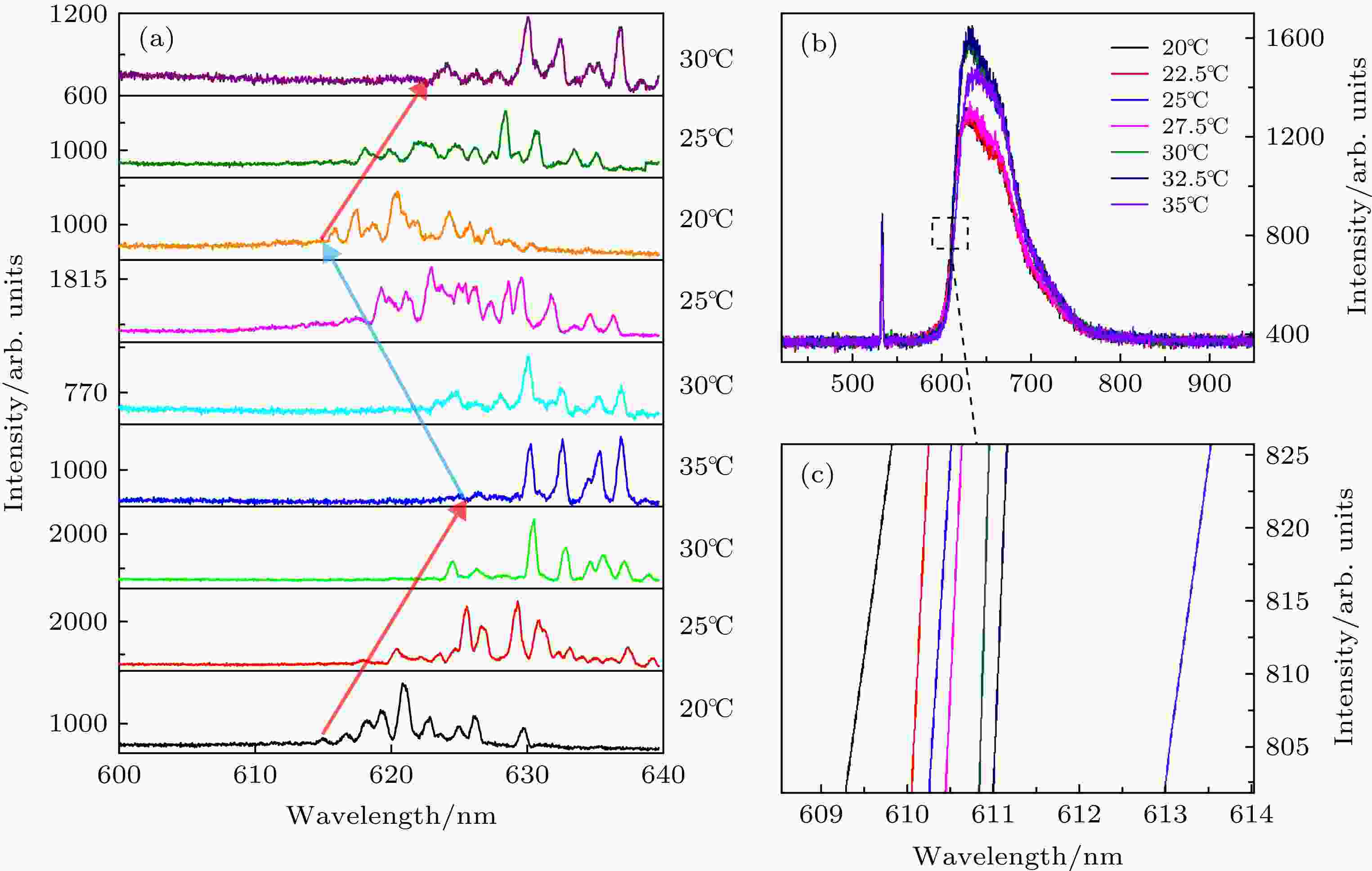 图 5 微球激光器和RhB染料的发射光谱与温度的关系
图 5 微球激光器和RhB染料的发射光谱与温度的关系Figure5. Emission spectrum of microsphere laser and RhB vs temperature.
将图5(a)中各温度下的主激射峰的波长数据做线性拟合, 拟合结果如图6(a)所示. 可以观察到主激射峰位置随对应温度的大小变化呈现出明确的规律性. 整体上, 随着温度的增加(20 ℃—35 ℃), 谱线呈现近线性的红移, 响应速率约为0.82 nm/℃. 为了排除温度变化引起的腔体尺寸变化从而导致的谐振峰飘移, 我们对不同温度下的微球进行了显微镜观察(如图6(b)), 发现当温度变化时, SU-8基微球的尺寸并没有变化. 然而当温度从20 ℃增加到35 ℃, RhB的光谱谱带仅红移了约4 nm, 少于主谐振峰的红移(约12 nm). 因此可以判断, 在本实验中, 荧光染料RhB的温度敏感特性对主激射峰的漂移起到了决定性的作用, 而灵敏的微球腔将该特性进一步放大.
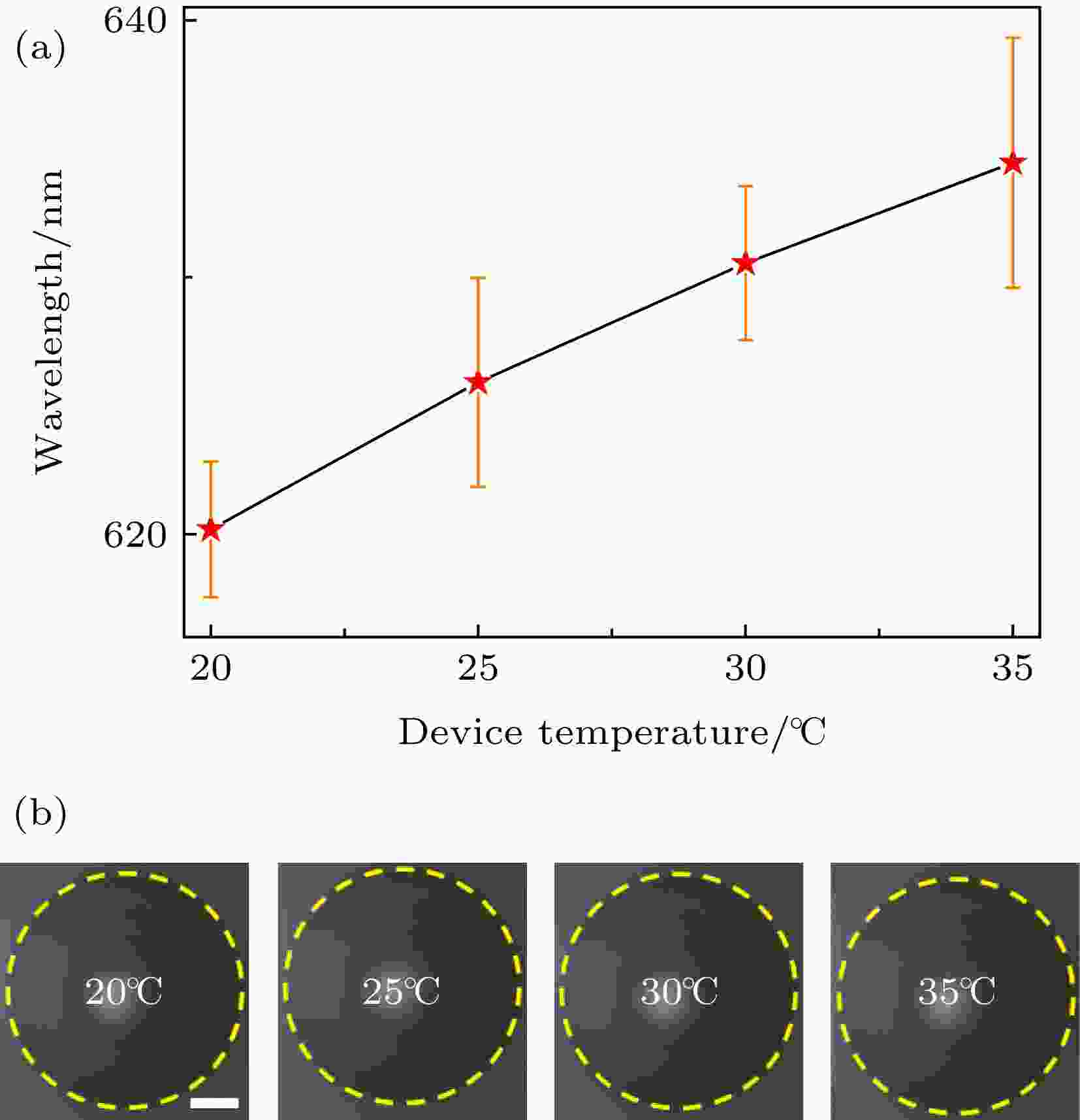 图 6 (a)主激射波长与器件温度的关系; (b)温度变化时, 器件尺寸不变; 比例尺5 μm
图 6 (a)主激射波长与器件温度的关系; (b)温度变化时, 器件尺寸不变; 比例尺5 μmFigure6. (a) Main resonance peak wavelength vs device temperature; (b) the device size does not change when the temperature changes. Scale bar 5 μm.
罗丹明B的发色团是带有3,6位取代氨基及其衍生物的氧杂蒽母体[37]. 两个芳环间通过—O—连接, 随着染料温度的升高, 分子热运动加大, 使罗丹明B分子基态能量变高, 进而使得基态到激发态的所需能量变小, 导致发射的荧光带整体红移, 新的荧光谱带与微腔固有振动模式产生新的共振, 从而导致主激射峰波长的红移[38]. 这也与赵小兵等[39]观察到的罗丹明6G/PMMA复合材料谱带位置随温度的移动规律一致.
